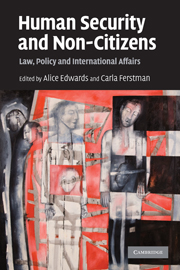Book contents
- Frontmatter
- Contents
- About the editors
- About the contributors
- Preface
- Acknowledgements
- Part I Human security, human rights and human dignity
- Part II Physical and legal security, armed conflict and refuge
- Part III Migration, development and environment
- Part IV National security and the ‘war on terror’
- 12 A distinction with a legal difference: the consequences of non-citizenship in the ‘war on terror’
- 13 Immigration law enforcement after 9/11 and human rights
- 14 Protection of non-citizens against removal under international human rights law
- 15 The human security framework and counter-terrorism: examining the rhetoric relating to ‘extraordinary renditions’
- 16 Legal routes to restoring individual rights at Guantanamo Bay: the effectiveness of habeas corpus applications and efforts to obtain diplomatic protection
- Index
13 - Immigration law enforcement after 9/11 and human rights
Published online by Cambridge University Press: 17 February 2011
- Frontmatter
- Contents
- About the editors
- About the contributors
- Preface
- Acknowledgements
- Part I Human security, human rights and human dignity
- Part II Physical and legal security, armed conflict and refuge
- Part III Migration, development and environment
- Part IV National security and the ‘war on terror’
- 12 A distinction with a legal difference: the consequences of non-citizenship in the ‘war on terror’
- 13 Immigration law enforcement after 9/11 and human rights
- 14 Protection of non-citizens against removal under international human rights law
- 15 The human security framework and counter-terrorism: examining the rhetoric relating to ‘extraordinary renditions’
- 16 Legal routes to restoring individual rights at Guantanamo Bay: the effectiveness of habeas corpus applications and efforts to obtain diplomatic protection
- Index
Summary
Introduction
In January 2002, the US Department of Justice announced the so-called Absconder Apprehension Initiative (AAI). The AAI is a programme designed to locate, arrest and deport those the US Government describes as ‘absconders’: that is, foreign nationals who have been ordered to be deported but have failed to leave the United States. Over 300,000 such persons were thought to be in the United States at that time. However, these ‘absconders’ were not to be pursued equally under the AAI. Rather, the US authorities declared that, in order to assist the campaign against terrorism, they would focus on the enforcement of deportation orders against approximately 6,000 ‘priority absconders’ who ‘come from countries in which there has been Al Qaeda terrorist presence or activity’. Although the government never explicitly identified these countries, those treated as ‘priority absconders’ came from a list of states all of which – except for the Philippines – have predominantly Arab and/or Muslim populations.
As I will demonstrate, the AAI is just one in a series of immigration enforcement initiatives adopted in recent years by Western states in the name of preventing terrorism. Typically, these initiatives target particular groups of foreign nationals based on their country of origin or nationality. The purpose of this chapter is to examine the impacts that these immigration measures have on human rights, in particular the right to non-discrimination.
- Type
- Chapter
- Information
- Human Security and Non-CitizensLaw, Policy and International Affairs, pp. 459 - 494Publisher: Cambridge University PressPrint publication year: 2010

